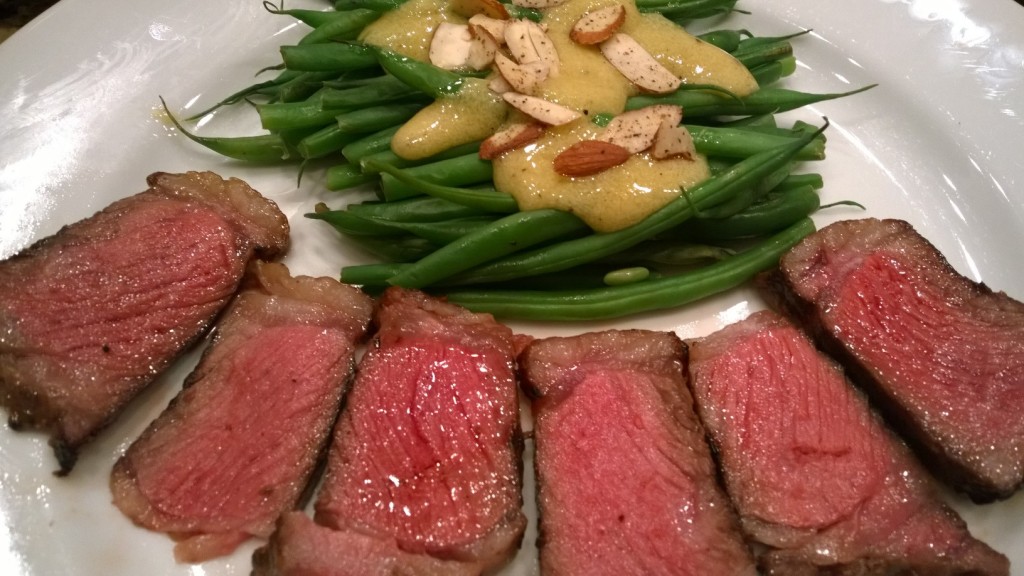 Take a look at the photograph and tell me what you see?
Take a look at the photograph and tell me what you see?
New York prime steak, cooked medium rare, and some green beans with a mustard sauce covered with some almonds.
Now tell me, if you ate the above plate would you be
(a) Wanting more, and be hungry later
(b) Satisfied for hours until morning
Then the next question – how many calories do you think are there?
Before I answer those questions let me tell you the experiment:
Eat Big but Small is an experiment to increase the quantity of food that is nutrient dense, but calorie light. It is not an experiment to be “fat free” or “sugar free” – it is simply an experiment to see how a person would do when we follow some simple rules of biology. Those rules are:
(a) Your stomach, and your brain, respond to volume.
(b) The appetite suppressive signals to the brain are in a bit of fat as well as protein
(c) Most people never eat the quantity of vegetables that they should
(d) Anorexia is not an option for weight loss
(e) You want to have a visually appealing plate of food
(f) You want to eat slowly to give your body a chance to enjoy the food, and when you are finished there will be the lowest level of appetite hormone circulating
It is simple- it easy easy – and one does not every feel as if they are going to deny themselves.
The answer is:
The steak was cooked Sous Vide to a medium rare temperature of 136 degrees F. It was then grilled to produce those nice marks – about 2 minutes a side. I took a piece of the New York Strip and thinly sliced it and on the plate are just over 3 ounces.
The green beans are Haricot Verde – there are 12 ounces of green beans and the dressing is an olive oil with dijon mustard. The recipe for green beans can be found on www.terrysimpson.com.
The first question:
I ate this over 30 minutes. It was a flavorful steak, with a perfect char, and the balance of the sweetness of the green beans with the bitter and sour notes from the mustard and the crunch of the almonds gave my tongue a delicious texture and flavor combination.
I was finished and was not hungry – in fact my stomach felt quite “full.” I was up late that night, later than usual, and five hours after dinner I still felt quite satisfied.
The next morning, awaking at 5 am, I did not feel the first pangs of hunger until five hours later at 10 am.
For those interested in calorie count- you may have done this by now, but there are less than 250 calories in the entire meal.
Try it – here is the science behind the principles:
The stomach received a lot of volume, mostly from the vegetables. Stretch in the stomach is one of the main factors to suppress appetite. It is the volume stretch behind the food as it leaves the esophagus in the first part of the stomach. This is where the Lap-Band works.
The fat in the meal came from the olive oil and some from the steak.
This gave me a lot of vegetables, and they were quite enjoyable, because I added a small quantity of a sauce that provided new flavors and a bit of almond for texture.
Eating less is anorexia, and while it works on some diets for a bit it leaves people hungry, and in some cases -rather nasty temperament.
The visual appeal of the food is there- it looked stunning on a plate, and it was a regular size plate, I didn’t fool myself into using a salad plate.
Eating it slowly, and with the small bites – I really enjoyed the steak- the many flavors.
Finally it was a nutrient rich food. I don’t wish to deny my body nutrients- the steak has many bio-available bits of nutrition as do the beans.
Let me know what you think- and try this. By the way, for my Lap-Band patients, this would be considered an appropriate meal. And here I am, without a Lap-Band, and I didn’t feel the need to eat more.
